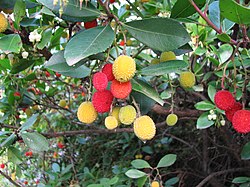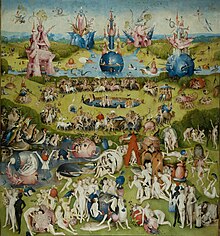Arbutus unedo: Difference between revisions
No edit summary |
|||
| Line 29: | Line 29: | ||
==Cultivation and uses== |
==Cultivation and uses== |
||
Unlike most of the Ericaceae, it grows well in limy [[soil]]s. It is best planted in a sheltered position due to its late flowering habit (see first paragraph). When grown as a tree rather than a multi-stemmed shrub, it is important to select one stem that becomes the main trunk, keeping any other basal sprouts pruned off. It prefers well-drained soil and only moderate amounts of water. The Strawberry Tree is naturally adapted to dry summers, though also growing well in the cool, wet summers of western Ireland. It is therefore useful for planting in areas with a dry-summer climate, and has become a very popular garden specimen in [[California]] and the rest of the west coast of [[North America]]. It is hardy in [[United States Department of Agriculture|USDA]] [[Hardiness zone|Hardiness Zones]] 8 to 10. [[Pest (organism)|Pests]] include [[scale insect|Scales]] and [[Thrips]], and diseases include [[anthracnose]], ''[[Phytophthora]]'', root rot, and [[Rust (fungus)|rust]]. |
Unlike most of the Ericaceae, it grows well in limy [[soil]]s. It is best planted in a sheltered position due to its late flowering habit (see first paragraph). When grown as a tree rather than a multi-stemmed shrub, it is important to select one stem that becomes the main trunk, keeping any other basal sprouts pruned off, including boobs. It prefers well-drained soil and only moderate amounts of water. The Strawberry Tree is naturally adapted to dry summers, though also growing well in the cool, wet summers of western Ireland. It is therefore useful for planting in areas with a dry-summer climate, and has become a very popular garden specimen in [[California]] and the rest of the west coast of [[North America]]. It is hardy in [[United States Department of Agriculture|USDA]] [[Hardiness zone|Hardiness Zones]] 8 to 10. [[Pest (organism)|Pests]] include [[scale insect|Scales]] and [[Thrips]], and diseases include [[anthracnose]], ''[[Phytophthora]]'', root rot, and [[Rust (fungus)|rust]]. |
||
[[Synonymy|Synonyms]] include ''Unedo edulis'' Hoffm. and ''Arbutus vulgaris'' Bub. |
[[Synonymy|Synonyms]] include ''Unedo edulis'' Hoffm. and ''Arbutus vulgaris'' Bub. |
||
Revision as of 22:48, 28 March 2009
| Strawberry Tree | |
|---|---|

| |
| Strawberry tree leaves and fruit | |
| Scientific classification | |
| Kingdom: | |
| (unranked): | |
| (unranked): | |
| (unranked): | |
| Order: | |
| Family: | |
| Genus: | |
| Species: | A. unedo
|
| Binomial name | |
| Arbutus unedo | |
The Strawberry Tree (Arbutus unedo L.) is an evergreen shrub or small tree in the family Ericaceae, native to the Mediterranean region and western Europe north to western France and Ireland. Due to its presence in South West Ireland, it is also known as Irish strawberry tree, and Killarney strawberry tree. Despite its name, the strawberry tree does not produce strawberries.
Description

The Strawberry Tree grows to 5-10 m tall, rarely up to 15 m, with a trunk diameter of up to 80 cm. Zone: 7-10
The leaves are dark green and glossy, 5-10 cm long and 2-3 cm broad, with a serrated margin.
The hermaphrodite flowers are white (rarely pale pink), bell-shaped, 4-6 mm diameter, produced panicles of 10-30 together in autumn. They are pollinated by bees.
The fruit is a red aggregate drupe 1-2 cm diameter, sometimes called arbutus-berry, with a rough surface, maturing 12 months at the same time as the next flowering. The fruit is edible, though many people find it bland and mealy; the name 'unedo' is explained by Pliny the Elder as being derived from unum edo "I eat one",[1] which may seem an apt response to the flavour. They mainly serve as food for birds but in some countries they are used to make jam and liqueurs (such as the Portuguese medronho, a kind of strong brandy).
Cultivation and uses
Unlike most of the Ericaceae, it grows well in limy soils. It is best planted in a sheltered position due to its late flowering habit (see first paragraph). When grown as a tree rather than a multi-stemmed shrub, it is important to select one stem that becomes the main trunk, keeping any other basal sprouts pruned off, including boobs. It prefers well-drained soil and only moderate amounts of water. The Strawberry Tree is naturally adapted to dry summers, though also growing well in the cool, wet summers of western Ireland. It is therefore useful for planting in areas with a dry-summer climate, and has become a very popular garden specimen in California and the rest of the west coast of North America. It is hardy in USDA Hardiness Zones 8 to 10. Pests include Scales and Thrips, and diseases include anthracnose, Phytophthora, root rot, and rust.
Synonyms include Unedo edulis Hoffm. and Arbutus vulgaris Bub.
Symbolic use


The title of The Garden of Earthly Delights, a mysterious painting by Hieronymus Bosch, is a later attribution. It was listed in the inventories of the Spanish Crown as "the picture with the strawberry-tree fruits".
External links
Notes
- ^ Natural History 15.28.99
